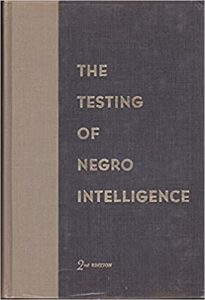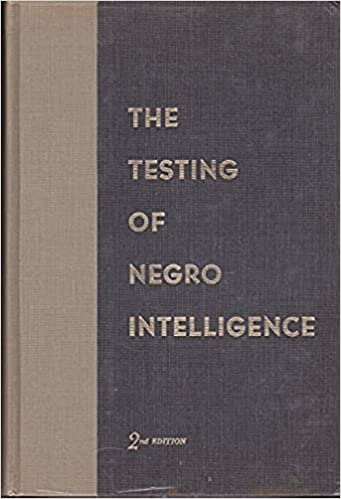
 Audrey M. Shuey (who even has a barebones Wikipedia page) is one of the most important female early researchers in intelligence research along with Barbara Burks and Leta Hollingworth.
Audrey M. Shuey (who even has a barebones Wikipedia page) is one of the most important female early researchers in intelligence research along with Barbara Burks and Leta Hollingworth.
- Shuey, Audrey M. (1966). The Testing of Negro Intelligence (2nd ed.). New York: Social Science Press.
- First edition: Shuey, A. M. (1958). The testing of Negro intelligence. Bell.
For readers who are only becoming familiar with these issues in recent times, her classic book offers a lesson:
Concluding Statement
The remarkable consistency in test results, whether they pertain to school or preschool children, to children between Ages 6 to 9 or 10 to 12, to children in Grades 1 to 3 or 4 to 7, to high school or college students, to enlisted men or officers in training in the Armed Forces—in World War I, World War II, or the Post-Korean period—to veterans of the Armed Forces, to homeless men or transients, to gifted or mentally deficient, to delinquent or criminal; the fact that differences between colored and white are present not only in the rural and urban South, but in the Border and Northern states; the fact that the colored preschool, school, and high school pupils living in Northern cities tested as far below the Southern urban white children as they did below the whites in the Northern cities; the fact that relatively small average differences were found between the IQ’s of Northern-born and Southern-born Negro children in Northern cities; the fact that Negro school children and high school pupils have achieved average IQ’s slightly lower in the past twenty years than between 1921 and 1944; the tendency toward greater variability among whites; the tendency for racial hybrids to score higher than those groups described as, or inferred to be, unmixed Negro; the evidence that the mean overlap is between 7 and 13 per cent; the evidence that the tested differences appear to be greater for logical analysis, abstract reasoning, and perceptual-motor tasks than for practical and concrete problems; the evidence that the tested differences may be a little less on verbal than on nonverbal tasks; the indication that the colored elementary or high school pupil has not been adversely affected in his tested performance by the presence of a white examiner; an indication that Negroes may have a greater sense of personal worth than whites, at least at the elementary, high school, and college levels; the unproved and probably erroneous assumption that Negroes have been less well motivated on tests than whites; the fact that differences were reported in practically all of the studies in which the cultural environment of the whites appeared to be similar in richness and complexity to that of the Negroes; the fact that in many comparisons, including those in which the colored have appeared to best advantage, Negro subjects have been either more representative of their racial group or more highly selected than the comparable whites; all taken together, inevitably point to the presence of native differences between Negroes and whites as determined by intelligence tests.
Thus, the current selection of null-genetics models generally represent not much new.
